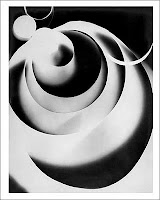Parallel to the early postwar years of the First
World War (1914-1918), the picture is sometimes ascribed to certain artistic
trends, participating in these movements more or less consciously and agreeing
in some points with the avant-gardes demonstrations.
The Dada movement led the technique of photomontage, developed by John Heartfield (1891 – 1968) and Raoul Hausmann (1886-1971), to be used as a propagandistic tool anti-war and anti-Nazi. The photomontage was also used by artists who belonged to different pictoric currents, as Paul Citroën, trained in the Bauhaus and founder of the Nieuwe Kunstschool; Georg Grosz, from the New Objectivity, or the dadaist Hannah Höch. Also Max Ernst used photomontage in his surrealist period. In 1918, Chistian Schad (1894-1982) proposes his schadographies, consisting on both collage and photography technique.
 |
| John Heartfield, Adolf the Superman, swallows gold and spouts junk, 1932 |
Futurism
remained beeing interested in photography and its relation with the movement,
advocated by Marinetti.Photomontages, overlay images and frames were still used
in the works of Fortunato Depero, Tato and Luigi Veronesi.
Alfred Stieglitz
(1864-1946) opened perspectives as a precursor of this médium of expression. In
1902 he organized a group which could only be joined by invitation, Photo-Secession, in order to forcé the
art world to recognize photography “as a distinctive médium of individual
expression”. Among its members there were Edward Steichen, Gertrude Kasebier,
Clarence H. White and Alvin Langdon Coburn. Photo-Secession
held tis own exhibitions ans published Camera
Work, a prestigious photography magazine, between 1902 and 1917. In 1917,
with the United States going to the war, they were forced to cancel the
publication of Camera Work and close
he gallery “291”. In 1925 opened the Intimate Gallery and exposes Paul Strand
(1890- 1976). In 1929, the hall An American Place promotes photography. Among the highlight
surrealist we could found Max Ernst and Paul Eluard, with photomontages and
collages, and in the journal of the surrealist movement, La
Révolution
surréaliste, there were publicated pictures of Atget and his collection of
parisian storefronts, with a surreal visión of the everyday life. The group
promoted the first photographs of Cartier-Bresson (1908-2004) and his visions
of suburban Paris. In 1947, Cartier-Bresson co-founded the agency Magnum with Robert
Capa, Bill Vandivert, David Seymour and George Rodger.
 |
| Eugène Atget, Avenue des Gobelins, 1925 |
Man Ray, after
beeing in contact with the dadaist, was associated with Surrealism and, besides
painting, he works on portrait photography, beeing even a fashion photographer
in the United States. His versatility enabled him to make films and also rayograms, photograms using objects on
the emulsioned paper and doing also solarized images. We should also talk about
Berenice Abbott, a pupil of Man Ray, in Paris and about Hans Bellmer as some of
the most representatives artists of Surrealism in photography.
 |
| Man Ray, Rayography, 1922 |
Alexander Rodchenko (1891-1956) and El Lissitski (1890-1941) are the main personalities of the constructivism movement. Rodchenko had ilustrated the Maiakovski’s poems in 1923 using the photomontage. In his photographys are imposed the oblique approach, the zenit or nadir views, taken sharply over the cityscape. El Lissitsky was also ascribed to he Suprematism and related to the Bauhaus, in which Laszlo Moholy-Nagy (1895-1946) during the Republic of Weimar (1919-1924) introduced this discipline. His publication Painting, Photography, Film, published in 1925, is the eighth volumen of the Books of the Bauhaus and is one of the main pillars of photography. In this work, Moholy-Nagy established a relation between painting and photography.
 |
| Alexander Rodchenko, On the telephone, 1928 |
 |
| Laszlo Moholy-Nagy, Konstruct, 1923 |
So the
photography adopted a documentary role of graphic reproduction, liberating the
painting and enhancing its plastic behaviour., increasingly away from the
faithful representation of reality. During the avant-gardes, the photography
takes a pictorial aesthetic which was subsequently abandoned, emerging a trend
purely photographic, in the reasearch of
a rigorous distinctness of everyday
life, the straight photography.
In
conclusion, in the modernity the artists used to destroy the principles of
tradition, where the most concrete manifestation of the free man is given in
art, experimenting and innovating continuosly, and taking care about only to the
instant sensations and the feeling that arises from the individual.
No comments:
Post a Comment